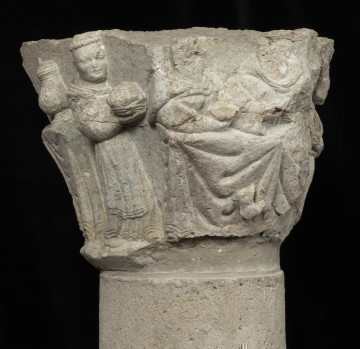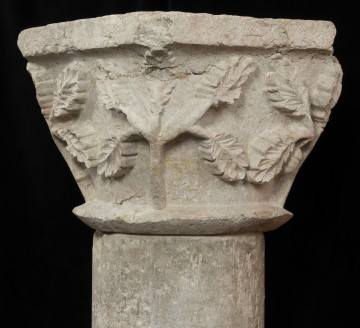
Capitol depicting meal of monks
1330 — 1340
National Museum in Szczecin
Part of the collection: Romanesque and early gothic stone capitals
The Cistercian monastery in Kołbacz, from where the group of bas-relief capitals originates, in the past the largest monastery in eastern Europe, remains one of the best known Medieval monuments from the area of Western Pomerania today. The heyday of this economically, socially and politically important centre elapsed along with the introduction of reformation in Pomerania in 1534. The monastery was secularised and transformed into a summer residence of Duke Barnim XI. Further history of Pomerania, including the downfall of the Duchy of Western Pomerania, the Swedish war and the fire in 1662 led to the survival of solely the church, the house of the conversi (unordained monks) and the abbot's house. The preserved stonemason’s structures are high class works testifying to the wealth and historical significance of the abbey. Relics scattered around the post-monastic area were noticed by the German naturalist Klöden, who mentioned them in 1935. The group of nine capitals, several bases and fragments of column shafts were secured and included in the collection of the Szczecin Antiquity Society in 1901. The decorations present a diverse array of figurative and vegetal motives. In particular the floral ornaments are a part of the canon of decorative motives willingly used by the Cistercian monks. Common grape vine, various creepers or stylised leaves have a symbolic character. They are related to the theme of the Passion, the worship of the Eucharist, the garden of Eden and the presentation of the tree of life. A luscious, succulent creeper, as if tumescent with the excess of life-giving juices, is encircling one of the Kołbacz capitals. This decoration has been described in literature as passiflora. The flower of a plant known as the passionflower, with its morphological structure reminiscent of the crown of thorns and the tools of the Passion, fits into the context of the Cistercian culture. However, the tropical plant that originates from the Americas became known in Europe only at the time of the great geographical discoveries in the 16th century. Impressive stylisation of the mysterious creeper on the Kołbacz capital hinders unequivocal classification of the genre. Its shape slightly resembles a lily or the leaves of the lady's mantle, namely plants that appear in Gothic paintings of gardens, whose symbolic is close to the Cistercian spirituality.
Kinga Krasnodębska
Author / creator
Dimensions
cały obiekt: height: 43 cm, width: 54 cm
Object type
capital (architecture)
Creation time / dating
Creation / finding place
Identification number
Location / status

1330 — 1340
National Museum in Szczecin

1330 — 1340
National Museum in Szczecin

1330 — 1340
National Museum in Szczecin
DISCOVER this TOPIC
Museum of King Jan III's Palace at Wilanów
DISCOVER this PATH
Educational path